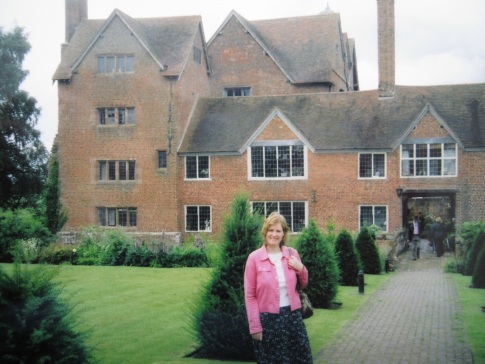
Angeline at the front elevation of the remarkable Harvington Hall, near Kidderminster.
Another Amazing Catholic Manor House
On Friday, we were considering the inspiring Catholic history of Baddesley Clinton manor house near Warwick. We thought that it would be good to follow that piece up with a similar one about the large and fascinating Harvington Hall.
Harvington Hall is another moated manor house, which stands approximately 25 miles to the west of Baddesley Clinton. It is worth studying, because it contains the finest surviving series of priest-holes in all of England.
A Masterpiece of the Genius of St. Nicholas Owen
First constructed in the 1580's by Humphrey Packington, the vast, moated manor house of Harvington Hall allows a unique insight into the creative genius and skill of St. Nicholas Owen.
As we mentioned in Friday's article on Baddesley Clinton, St. Nicholas Owen was a Jesuit lay brother and carpenter, who constructed secret priest-holes in the houses of recusant Catholic families all over England.
These were necessary to provide shelter for Catholic priests from raiding pursuivants, during a time when it was high treason, punishable by hanging, drawing and quartering, to be a Catholic priest operating within the realm of Queen Elizabeth I. Even those who shielded priests could be executed.
Four of the intriguing hiding places at Harvington Hall bear the hallmarks of St. Nicholas Owen.
Given the extent of the work involved at Harvington Hall, it seems a fair conjecture to us to say that the original designs for the central Great Staircase, and therefore of the entire house itself, would always have been structured around the provision of hiding places and the secret access places built into them.
That would mean that, unlike in other places where St. Nicholas Owen needed to apply his lateral thinking and carpentry skills to create hiding places within already existing structures, the original planning for Harvington Hall could have been one in which the form of the whole house would follow the function of sheltering priests. As such, it would be a kind of ''priest-hole designer's dream house'' for him to enjoy exercising his creative genius. It is an interesting theory.Â
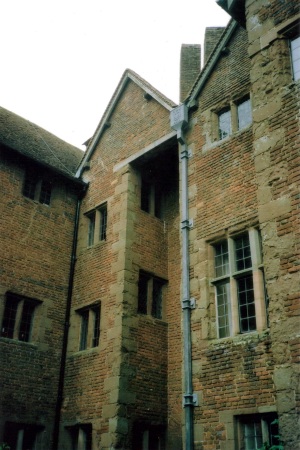
Be that as it may, the construction of Harvington Hall provided St. Nicholas Owen with an unprecedented opportunity to develop a series of very sophisticated priestly hiding places.
Stairway to Heaven
Cross-section drawings of the sprawling Harvington Hall reveal an ingenious series of hidden passageways, leading on to various secret hiding places. Though disparate, each of the unique hides is situated around the central structure of the Great Staircase.
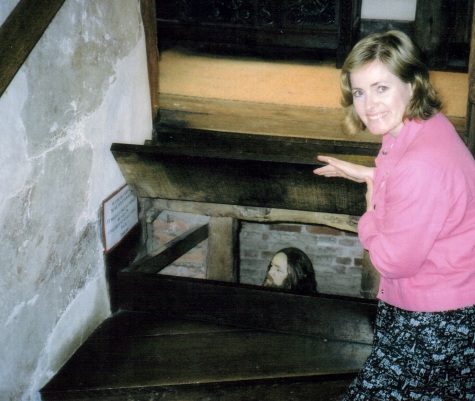
Angeline lifts one of the main stairs to reveal a hiding space for Catholic priests on the run from priest-hunting pursuivants. As you can see, the curators have provided a mock-up of their very own Elizabethan-era priest, kneeling in prayerful supplication in the ''priest-hole''.
As Angeline demonstrates here, one of the main stairs is hinged and can be lifted up to reveal a small hidden room within the staircase proper. The position of the wax-effigy of a hidden priest kneeling in prayer, gives some idea of the amount of space available to someone hiding there. It is not a bad space, considering that some pursuivant raids could last for hours, or even days if the raiders stubbornly remained on or near to the premises.
A few steps higher than this one, two angled treads hinge upwards to provide a small triangular hide. In his informative book, How We Built Britain (2007), which was based on his BBC TV-series of the same name, David Dimbleby suggests that this little hiding place could have contained jewels and some money. However, we think that the historian Alice Hogg may be rather closer to the mark, in her captivating narrative history God's Secret Agents - Queen Elizabeth's Forbidden Priests and the Hatching of the Gunpowder Plot (2005), when she conjectures that the books and equipment for Holy Mass would likely have been stored here.
A Clean Sweep
The young, as well as the young at heart, will likely love the ingenious false fireplace in Harvington Hall's Marble Room.
A carefully spread layer of soot would likely have fooled most observers into thinking that this was just a regular brick fireplace. However, it is not real; stairs up inside the false chimney lead on to a hidden passageway in a maze of attics. There are two hides within these attics; one of which was situated behind a false wall, behind which as many as a dozen adults could safely hide.
Lost in a Book
So well concealed are St. Nicholas Owen's hides at Harvington that one of them was only discovered by accident in the late 1890's.
At that time, the hall had fallen derelict and some young boys had ventured into the empty and damaged building to play. One of them, having climbed up into a space in Dr. Dodd's library, fell against an upright beam. This suddenly pivoted upwards to reveal a further narrow hiding place of eight feet in length, five feet in height and three feet in width.
Closer inspection eventually enabled further understanding of St. Nicholas Owens' giftedness; for inside was a specially constructed stool, too wide to have been pushed into the narrow space, which must have been carved outside, and then assembled in situ, to allow a little rest to any weary priests who might have been forced to hide within the tight confines of that particular hide during the Elizabethan persecution.
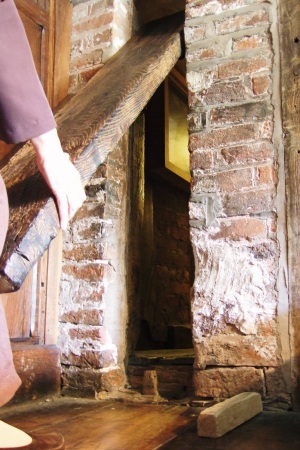
Whilst this image shows the pivoting beam being raised to reveal the inner space, the picture below shows that this beam is itself high up on a raised platform. During Elizabethan times, the place that is now marked below with a red rope would have been covered with book-cupboard doors and removable wooden shelves would have been placed within. Should raiders have arrived at the front door of the hall, any hiding priest could have scrambled up through the cupboard and been hastily installed behind the pivoting beam; whilst assistants could have quickly assembled the facade of the bookcase, inner shelves and, no doubt, a selection of books, across the frontage. It would thus have been an excellent, if rather stuffy and restricted, hiding place!
Catholic Mirth
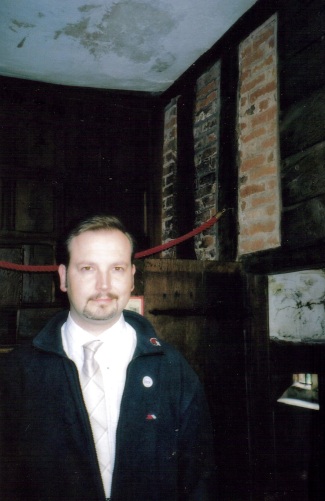
You there! Stop smirking, straighten your tie and pay attention. That way, you might actually learn something! Behind you is a raised platform with a red rope. That would originally have been covered with a false bookcase. To the right of the red rope is the upright pivoting beam, which leads into the narrow priest-hole within.
I must say that I was chuckling all the way round Harvington Hall when we visited the place several years ago. This is because there is something of that truly Catholic quality of joyful mirth in the constructions there. G.K. Chesterton was on to something when he said that angels can fly, because they take themselves lightly.
I would say that, even though the dangers faced by priests, recusant families and their servants in those times were extremely grave, there is nevertheless something tongue-in-cheek about St. Nicholas Owens' hiding places. I bet he had a deal of fun designing them!
The various hides at Harvington, including also later additions such as the lifting floor panel in the high chapel, the wide space in the kitchen shaft and the great loft hide, have something about them which calls to mind the fast witticisms, and more importantly the underlying charitable kindness, displayed by some of the martyrs as they were led out to die for Christ and the True Faith on the scaffold.
As an enclosed nun once explained to us during a tour of the martyrs' museum at Tyburn Convent in London, it was the charity and forgiveness of the martyrs at their unjust trials and deaths which makes them such valuable witnesses down to the present day. Like Christ, they mercifully prayed for the ultimate salvation of their enemies. What a deep prayer life those martyrs must have cultivated.
Subsequent History
Dr. Dodd, for whom the library was named, was actually a pseudonym of Fr. Hugh Tootell, who lived at the hall and wrote a church history in that room during the 1700's.
Out in the grounds is the marvellous Elizabethan Malt House. The lower sandstone and upper brick-timber has been reconstructed to appear as it would have done in its heyday.
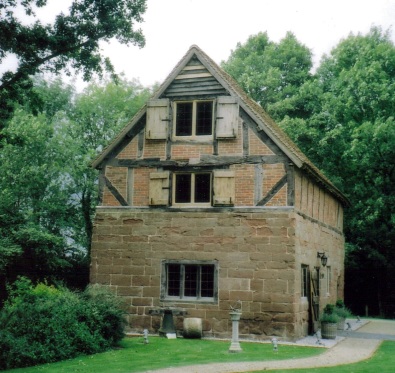
The interior houses a restored 18th-Century malting kiln and now features modern educational technologies and resources.
There is also a restored Georgian-period chapel in the grounds at Harvington Hall. By that era, anti-Catholic persecution had certainly subsided in England, at least in its most virulent forms. Nevertheless, Catholics still ''kept their heads down'' so to speak. As such, the chapel is camouflaged by two parallel walls, running at 10ft in height between the chapel and courtyard, to provide discreet access, thus sheltered from any prying eyes which may have been watching from the nearby fields.
My Lord and the Angel
If you are interested in learning more about Harvington Hall, we recommend Rosie Martin's enchanting book, My Lord and the Angel: Encounter at Harvington Hall (1997).
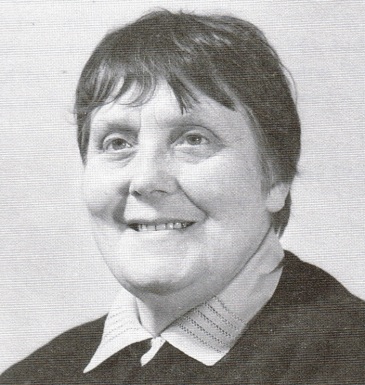
As a small child growing up in the 1920's, Rosie had wandered into the, then, largely derelict Harvington Hall. During her secret visit, she had encountered the other-worldly Archbishop Edward Isley of Birmingham, who was then living in part of the hall, and his devoted sister. As the venerable Archbishop was being addressed as ''My Lord'' by the old lady, the infant Rosie imagined in her innocence that this mysterious figure must be God.
In a manner which is at once down-to-earth, and yet also deeply mystical, Rosie's book touchingly recounts her lifelong journey, from her subsequent childhood conversion and reception into the Catholic Faith until her life as a Catholic lady of mature years and outlook.
The consistent theme at the centre of all her varied experiences, and of her deepening understanding and spirituality, is always that sense of enchantment and encounter which she first received as a little girl in Harvington Hall.
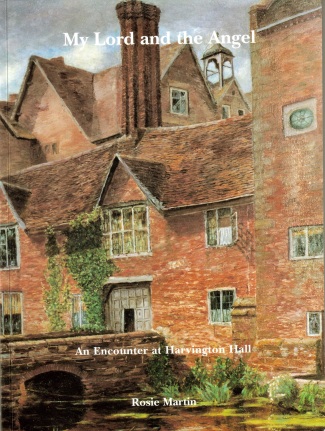
Handing on the Legacy
As our article has already twice alluded, Harvington Hall had fallen into a largely derelict condition during the 19th and early 20th-centuries. Incredibly, the original Central Staircase was removed and taken to Coughton Court in 1910.Â
Coughton Court has its own remarkable recusant Catholic history. Indeed, in 1858, a cleverly concealed priest-hole was rediscovered in the Tower Room there. Again, when Coughton Court was fully opened up in 1910, the priest's hiding place was found to contain a rope ladder, small tapestry, bedding and a folding altar, made from leather.
As a double-hide, this meant that, even if pursuivants had discovered the outer space, they would have been unlikely to make the further discovery of the second, deeper priest-hole within.
However, Harvington Hall is itself now restored, owned and run through a trust by the Catholic Archdiocese of Birmingham.
The central stairway, complete with hides, was carefully recreated on site to provide this important window onto such an important period of English Catholic history.
As was the case with Baddesley Clinton, we highly recommend this manor house as a place for prayerful reflection on the legacy of the English Martyrs and the truths of the Catholic Faith.
Visitors today can also enjoy a pleasant tea-room, a decent souvenir shop, walks in the lovely grounds and a visit to the herb gardens, which have been recreated in the style of those from the Elizabethan era.
Looking Back to Go Forward
The title of our article today is taken from Isaiah 58, which graces the heraldic mantel in the fully restored and wood-pannelled Great Chamber at Harvington Hall. In Latin it reads: Aedificabuntur in te deserta saeculorum. In English, that is rendered as, What was ancient and abandoned, you shall rebuild.
As well as being an apposite motto for the resurrected Harvington Hall, pointing beyond itself to that of Our Lord and Saviour, Jesus Christ, we also think it very apt for Catholics striving to remain faithful and, by the help of God's grace, to restore the Church in our own days.
Although no priests were ever captured from Harvington Hall - the hides were that good! - the martyr-priest St. John Wall did live and work there for several years. And, of course, there is the very tangible link, through his own planning and work, to St. Nicholas Owen himself.
Prior to his own capture and martyrdom in 1606 AD, St. Nicholas was actually starved out of one of his own hides over at Hindlip House. Sadly, Hindlip was demolished in 1815, but extant descriptions of the series of hiding places there reveal striking similarities to those of Harvington.
Harvington Hall is also a good place to pray, because of the fine Small Chapel; enhanced as it is by the wall paintings from around 1600 AD, which depict red and white droplets to call to mind the Blood and Water flowing from the Heart of Christ at His Sacred Passion.
The courage, ingenuity, love and faith of the English Catholic martyrs and recusants can still teach us a great deal in the difficult times through which you and I now live. They kept the light of the Catholic Faith burning here in England, through dark centuries when the Holy Sacrifice of the Mass and the Sacred Priesthood were outlawed under extreme penalties. When the Faith was gradually allowed to return, through the changing flux of history, and the massive influx of Catholic immigrants through the Industrial Revolution and the Irish Famines, there were found a few who had never lost the Faith of Our Fathers, and who had kept practicing the Faith in hidden places throughout all of those difficult centuries.
One could even posit that the graces won by these heroes paved the way for the many thousands who were received into the Catholic Church in Great Britain between the 1850's and 1950's; a heritage which has been largely squandered in the decades following the Second Vatican Council.
May the witness and prayers of the Holy Martyrs and recusants help us to be inspired and to Keep the Faith!
Holy martyrs of England and Wales - pray for us!  Â



